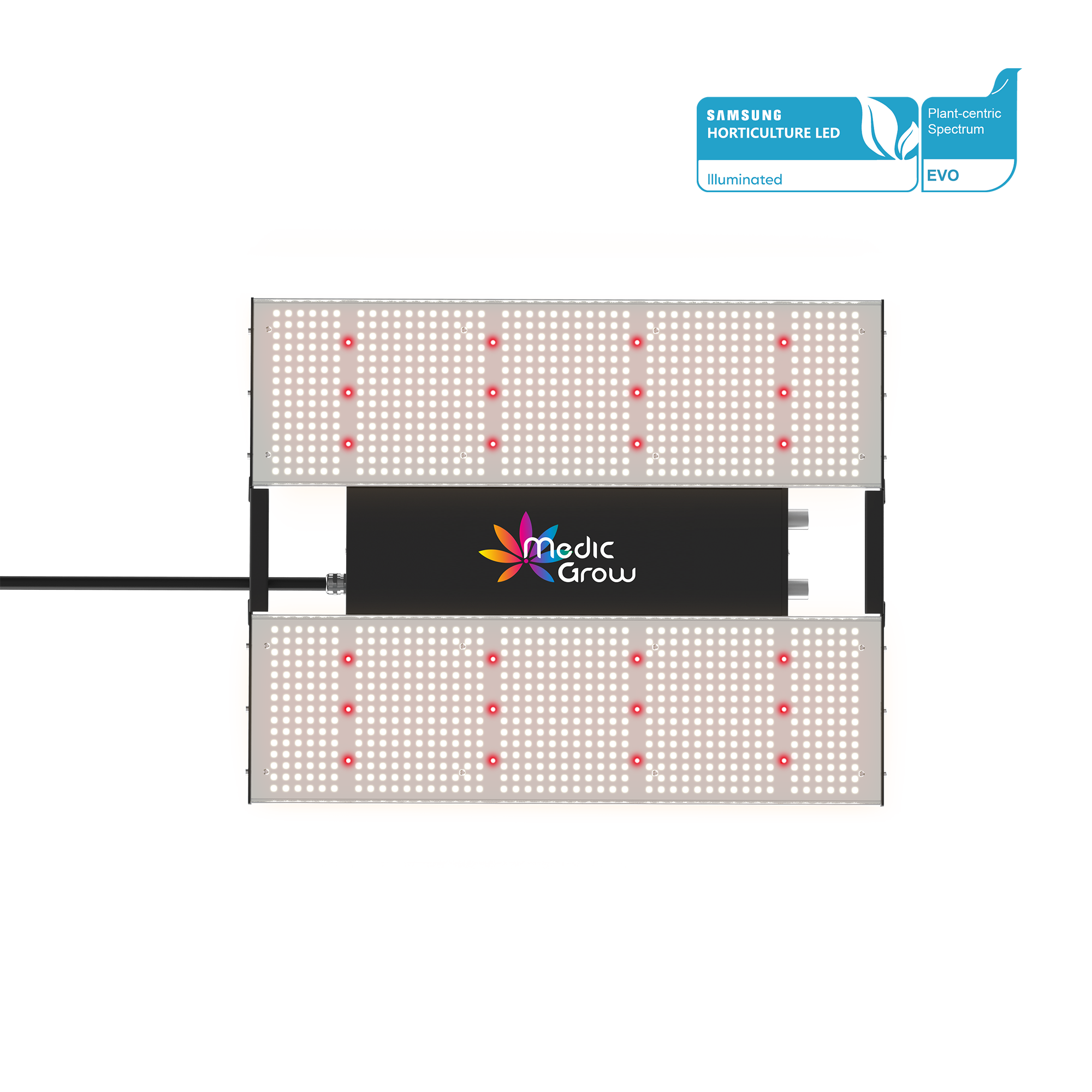新订户可享受9% 折扣

什么原因导致植物叶子上出现白斑以及如何处理?
在种植植物时,您可能会注意到植物叶子上有白斑。植物叶子上这些微小的白斑可能令人沮丧,但不用担心,植物叶子上可能有白斑而不是霉菌。
它们可能是由真菌或细菌感染、营养不良或小昆虫引起的,可以用一些简单的方法治疗。在本综合指南中,我们将帮助您找出植物叶子上出现白斑的原因以及如何去除植物叶子上的白斑。
主要内容:
是什么原因导致植物叶子上出现白斑?
植物叶子上的白斑可能是由害虫、疾病或营养不良引起的。这包括白粉病、红蜘蛛、钙或镁缺乏、水肿、杀虫剂的化学损害以及某些病毒感染。
及时诊断和治疗植物叶片上的白斑对于植物的健康和生长至关重要。那么让我们来看看植物叶片上出现白斑的第一个主要原因:植物疾病。
病害
植物叶子上的白斑可能是由各种疾病引起的,包括真菌和病毒感染。其中最常见的是白粉病,因为它的真菌病原体会通过空气传播,影响多种植物。
白粉病
白粉病是一种常见的真菌病害,其特征是叶子、茎和芽上出现白色粉状斑点,类似于表面撒的面粉。这种疾病在温暖(60-80°F)和干燥的环境中迅速传播。
霜霉病
霜霉病是一种真菌病,在凉爽(58-78°F)和潮湿(湿度 >85%)的环境中生长旺盛。它通常表现为叶子背面的白色或灰色霉菌,有时会导致叶子上表面出现黄色斑点。
霜霉病比白粉病更具破坏性。如果不加以治疗,霜霉病会对农作物造成严重损害,一周内可导致所有植物死亡。因此,必须立即摘除受感染的叶子,并进行本文后半部分提到的治疗。
无论是白粉病、霜霉病还是植物叶片上的其他白色斑点感染,预防都是关键。使用全光谱生长灯和生长风扇保持良好的空气流通、适当的湿度和温度,可以有效预防白粉病和霜霉病。

霜霉病与白粉病
细菌感染
导致植物叶子出现白斑的主要细菌感染如下:
细菌性叶斑病
细菌性叶斑病是由高湿度、高温和密集种植引起的。这种疾病会导致叶子上出现水渍状斑点,最初呈深绿色,然后变成白色或黄色。这些斑点也可能被黄色晕圈包围。
青枯病
细菌性枯萎病感染是由于温暖潮湿的环境、根部或茎部受损以及土壤污染而发生的。细菌性枯萎病症状包括叶子从边缘开始变白或变黄,逐渐蔓延到整个叶子,最终导致叶子和整个植物枯萎。
细菌条纹
细菌性条纹病感染主要由高湿度、风雨传播细菌以及受感染的种子引起。症状包括叶子上出现白色或淡黄色条纹状斑点。这些斑点经常融合,导致大面积变色和叶子枯萎。
通过了解这些导致植物叶子上出现白色斑点的细菌感染,您可以采取预防措施来保护您的植物并保持花园的健康。
害虫
由于湿度高、温度高、施肥过多和种植过于拥挤等因素,植物经常会被叶子上的白斑虫所吸引。这些叶子上的白斑虫的出现情况如下:
- 红蜘蛛:红蜘蛛体型微小,难以发现,通常呈红色、黄色或绿色。这些微小的害虫通过吸取植物汁液生存,导致叶子上出现黄色或白色斑点,植物上经常出现脆弱的蜘蛛网。
- 蚜虫:蚜虫是一种小型软体昆虫,颜色各异,如绿色、黄色、黑色、红色或棕色。它们以植物汁液为食,导致叶子上出现白斑或变色。它们释放的蜜露会吸引其他害虫或导致霉菌生长。
- 粉虱:粉虱是一种体型较小的白色昆虫,翅膀上覆盖着一层白色粉末。这些微小的白色飞虫以植物汁液为食,导致叶子上出现白色斑点或褪色区域。
- 蓟马:蓟马体型细长,颜色从黄色到棕色不等。它们刺穿叶子表面吸食汁液,导致叶子上出现白色或银色的斑点或条纹。
- 潜叶虫:潜叶虫的幼虫很小,像蛆虫一样,成虫通常是小甲虫。幼虫在叶子内部挖洞,留下白色、蜿蜒、类似隧道的痕迹。
您可以通过仔细检查植物上的斑点、条纹、网状物和害虫的外观来识别这些害虫。使用放大镜可以帮助您更清楚地看到这些微小的害虫。

植物上的粉虱
营养缺乏
植物叶子上的白斑也可能是由于各种营养素缺乏造成的。以下是一些可能导致叶子上出现白斑的营养素缺乏情况:
- 缺钙:缺钙时,新叶和生长点会出现白色或黄色斑点,叶尖和边缘可能会开始枯萎。在严重的情况下,植物的生长点可能会死亡。
- 缺镁:缺镁会导致老叶失绿,叶脉保持绿色。叶子上可能出现白色斑点或斑块,最终整个叶子会变成黄白色。
- 缺硫:缺硫会导致整片叶子变黄,严重时新叶会变成黄白色,并出现白色斑点或斑块。
这些营养缺乏可能是由于土壤中缺乏特定营养物质、土壤 pH 值不合适或施肥不均衡造成的。现在您知道了植物叶子上的白斑是什么,让我们采取一些简单的方法来帮助您的植物快速恢复健康。
如何去除植物上的白斑
一旦植物叶片感染白斑,无论是霜霉病、白粉病还是非霉菌,都很难彻底根除。因此,对于园丁来说,重点应该放在预防而不是治疗上,例如选择抗病植物种子。
如果你的植物不幸感染了白斑,请按照下面的解决方案,然后快速修复患病的植物。
如何去除植物上的白色真菌?
如果发现植物叶子上有白粉病或霜霉病等真菌引起的白色斑点,请先去除受感染的叶子、树枝、花朵或果实,以防止真菌传播。在严重的情况下,你可能需要移除整株植物以保护花园的其余部分。
通过支撑植物和/或选择性修剪来确保良好的空气流通,并在清晨浇水,以便植物在白天干燥。保持植物周围相对较低的湿度很重要。
此外,避免土壤过于拥挤、浇水过多和排水不良。出于同样的原因,请清除杂草。如果您种植室内植物,请使用 Medicgrow种植帐篷套件来保持相对较低的湿度和适当的光照强度。
您可以使用针对霜霉病和白粉病的杀菌剂。我推荐使用印楝油和铜或磷基杀菌剂,因为它们非常有效。白醋和肥皂水与酒精的混合物也可用于治疗。关键是每天晚上将其涂抹在受感染的植物上。

植物上出现白斑
如何治疗植物叶子上的白斑而不是霉菌?
植物叶子上的白斑(而非霉菌)可能是由于害虫侵扰、营养不足或环境因素造成的。常见害虫包括红蜘蛛、蚜虫和蓟马。
治疗方法包括用水冲洗植物、使用杀虫皂或印楝油,以及引入有益的捕食者,如捕食螨、瓢虫、草蛉和食蚜蝇。
缺乏钙、镁、锌等营养物质也会导致白斑。这些问题可以通过施用含有相应营养物质的土壤添加剂或叶面喷剂以及调节土壤 pH 值来解决。
此外,日晒或缺水等环境因素也会导致白斑。将植物放置在光照充足但不要过度晒伤的地方。保持土壤均匀湿润,在生长季节增加浇水量,在休眠期减少浇水量,以防止积水。
对于室内植物种植者,我们建议使用LED 生长灯,尤其是带定时器的生长灯,如 Medicgrow Spectrum-Y。这些生长灯可以控制光照时间和强度,为植物生长创造最佳环境。
结论
总结一下,处理叶子上的白斑并不难,关键是要预防。有时一旦植物叶子上出现白斑,可能就太迟了。使用上面提到的植物生长风扇或紫外线生长灯调整植物的生长环境可以有效地防止植物叶子出现白斑。
关于植物叶子上白斑的常见问题
1. 金缕梅叶子上的白斑是什么?
各种因素都可能导致金缕梅叶子上出现白斑。以下是 3 个常见原因:
- 真菌感染:白粉病或叶斑病等疾病会导致金缕梅叶子上出现白斑。白粉病表现为叶子上覆盖一层白色粉状物,而叶斑病则会产生小白斑,这些小白斑可能会随着时间的推移而变大。
- 害虫:红蜘蛛或介壳虫等昆虫会以金缕梅叶子为食,在它们刺穿叶子表面并吸食汁液的地方造成白色或黄色的小斑点。
- 环境压力:过度暴露在阳光下、高温或空气流通不畅等因素都会给金缕梅植物带来压力,导致叶子上出现白斑,这是压力或损伤的症状。
为了正确诊断和治疗金缕梅叶子上的白斑,仔细检查植物并找出根本原因非常重要。治疗可能涉及改善生长条件,并在必要时使用适当的杀菌剂或杀虫剂。
2. 什么原因导致番茄叶子上出现白斑?
番茄叶子上的白斑可归因于多种因素,包括白粉病等真菌疾病、细菌感染(如细菌性斑点)、病毒性疾病以及粉虱和红蜘蛛等害虫侵扰。
此外,不当的灌溉方式,例如过度灌溉或维护不善的滴灌系统,可能会导致番茄叶片长时间保持湿润,为真菌和细菌的生长创造有利条件。
3. 黄瓜叶子上的白斑是什么?
黄瓜叶片出现白斑可能是由于相对湿度较低导致的,这有利于白粉病和红蜘蛛的生长。对于黄瓜周围相对湿度较低的情况,可以安装喷雾装置,以保持较高的相对湿度,同时避免黄瓜根部被水淹没。
此外,应在黄瓜种植前 2-4 周在准备好的土壤苗床上使用熏蒸剂。使用箔纸和其他反光覆盖物来驱除秋季种植的黄瓜中传播病毒的蚜虫。
钾还能增强黄瓜的抗病能力,叶面喷洒钾盐溶液已被证明可以控制黄瓜叶片上的白粉病。
另请阅读: 为什么我的黄瓜叶子变黄了?
特色产品
博客文章

Behind the Glow: The Science of Precision in Every Medic Grow Light

Medic LED Grow Lights: Leading the way in horticultural lighting standards

🌱 LED Grow Lights: A Hardware Engineer’s Buying Guide

- led grow light
💡 Top + Bottom Grow Lights: The Future of Precision Cultivation
如有任何想法请联系我们!
- 选择一个选项会导致整个页面刷新。
!




























